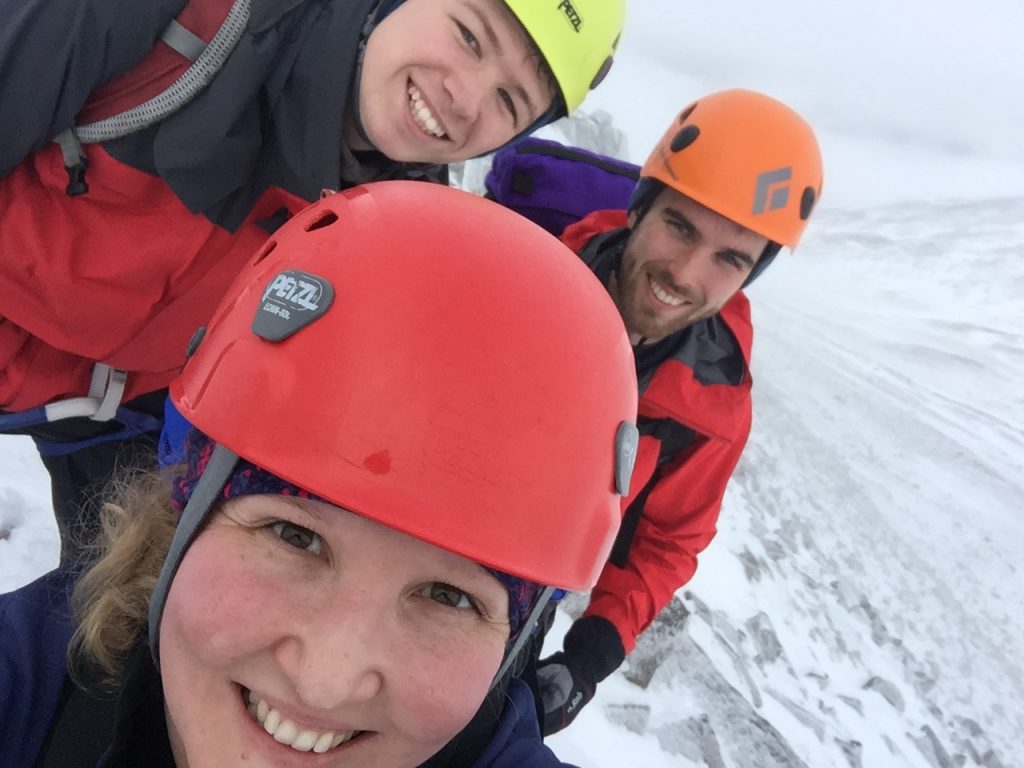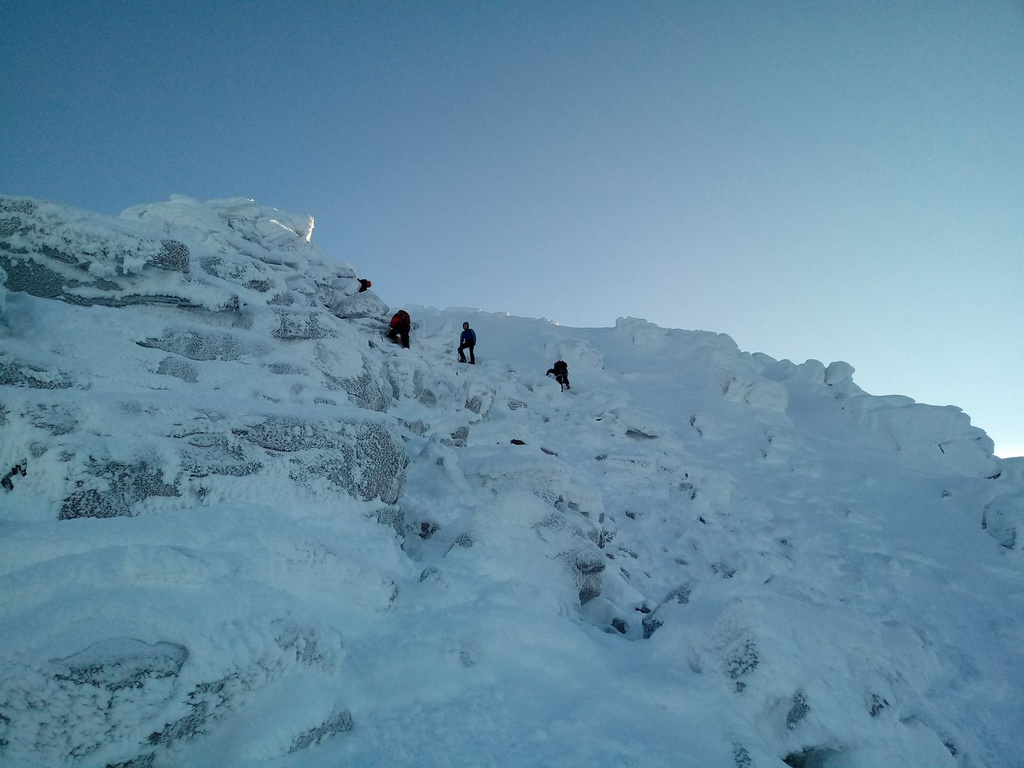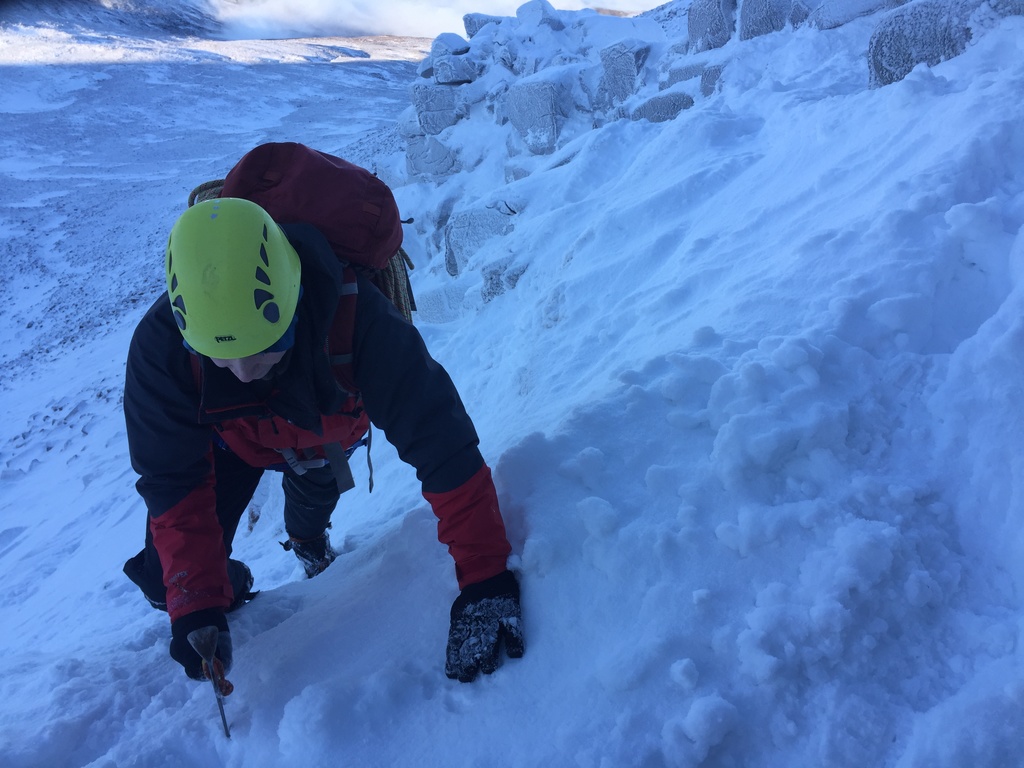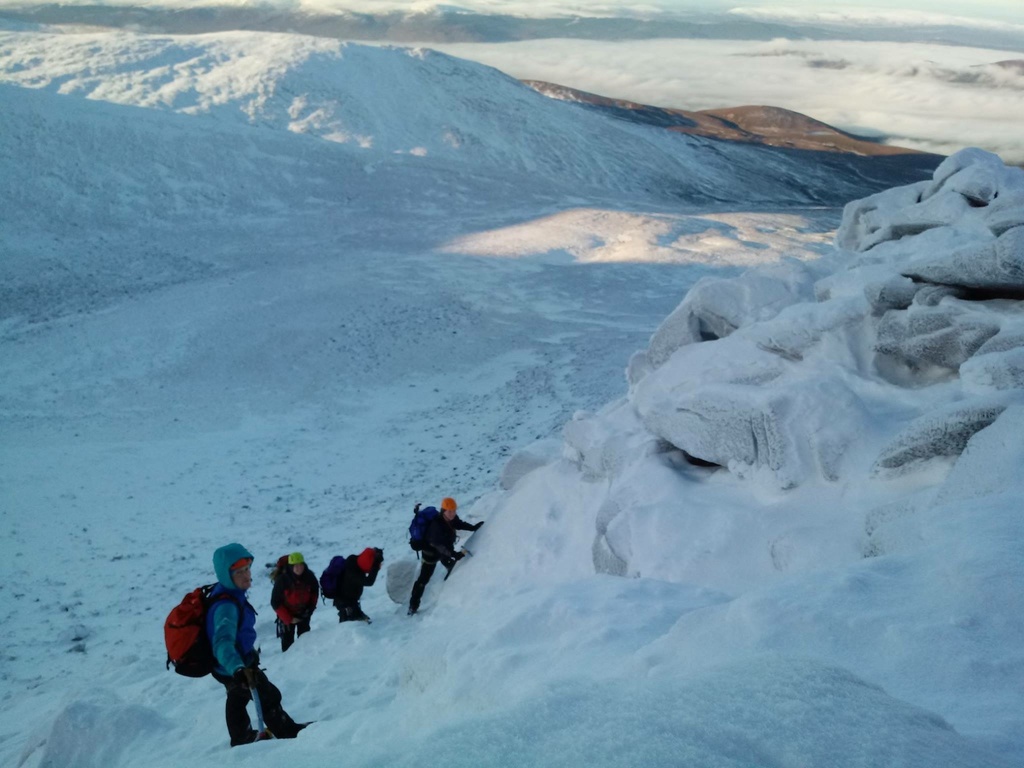
At this time of year you might be preparing to book onto some winter training. This is a popular topic of conversation around the camp fire and the pub etc. so since a small group of us did courses together at Glenmore Lodge I thought I would share my thoughts on our experience for anyone considering doing the same.
Glenmore Lodge is a leading outdoor training centre in Scotland. Based in the Cairngorms they offer a wide range of courses from bike maintenance to kayaking but we are most interested in the winter skills, winter mountaineering and winter climbing courses.

So how will you benefit from doing a winter skills course? Well first of all you will be safer, more confident and more able to take care of yourself in the mountains. This then means you will be able to take full advantage of being a member of a mountaineering club because you will be able to join groups doing more adventurous routes on the winter trips or even lead your own little (or even big) expeditions. Of course you could gradually gain this experience over the years if you are able to find friends to share their own knowledge and experience but doing a course is a very effective way of making sure you know what you are taking on when you head off into the mountains in winter.
Value for Money
So is it a good use of hard earned cash? The 5 day winter mountaineering course is quite an investment (For Jan 2020 it is advertised for £725 with accommodation). I certainly felt like I was getting value for money. To say accommodation was included, food, hiring of kit, evening skills lectures, our group was max 4 to an instructor, I was pretty happy. I also figured that I wouldn’t spend much while I was there (even though I felt the bar was quite pricey). I compared it with the option of doing a course in the Alps and, even though it’s not the same thing, it looked to me like it would have cost me twice as much.
Choose the right course for you
I struggled with deciding which course to do. You can choose between a 2 day weekend or 5 day Monday to Friday and whether to do (in order of difficulty/seriousness) winter skills, winter mountaineering, winter climbing or winter lead climbing. It does obviously depend on the individual. If you are bold, quite hardy with a good level of physical fitness and you have the head for it then you will progress more easily. When the weather kicks off (which it usually does) it can be brutal.

I phoned in advance to discuss it with Glenmore Lodge and the person I spoke to was insistent that you must have previous experience with axe and crampons before doing the winter mountaineering course so I did the 2 day winter skills first and the 5 day mountaineering straight after. There were at least 2 other people in my group that did the same thing. Although 7 full consecutive mountain days was quite full on, it’s a long way to travel up to Aviemore so I wanted to make the most of it. I thought it was a good decision as the winter skills weekend eased me nicely into the winter mountaineering. If I had straight away jumped onto the much steeper ground then I think I might have had a bit of a shock. On the other hand one of my friends who was more confident and more physically capable then I was went straight onto winter mountaineering with very little winter walking experience and he got on just fine.

The winter skills covers mainly walking and navigation although they will expect you to have some basic knowledge of navigation to start from. The most fun bit of the course is ice axe arrest. This is also much more dramatically demonstrated on the steeper ground in the winter mountaineering course. We actually only had crampons on for about 15 minutes over 2 days of winter skills. There is a lot of detail around avalanche risk and you take out shovels, probes and transceivers and learn how to use them. Although I have no plan to invest in an expensive transceiver myself, knowing what to do after an avalanche is important and I found it all very interesting. This will be good knowledge to have for other winter pursuits, for example if you wanted to get into ski touring then a transceiver would be essential. It brings a smile to my face imagining how much safer the Cairngorms are in winter due to all those winter skills trainees trudging around everywhere with their transceivers and big shovels!
On the 5 day mountaineering course highlights include making an abseil from a snow bollard, body belay, digging bucket seats and making buried axe belays. We learned some really useful rope skills and generally how to be more efficient and move quickly. We were all used to summer trad climbing and all the faff that comes with it so we were amazed at actually how much about rope skills we still had to learn.

For the Winter climbing and Leading courses you should at least have rope skills and summer climbing experience as well as the winter skills to get to the start of the climb. That said one of my friends on the climbing course did have someone in his group that was not a climber but because the climbing course is only 2 to an instructor they were able to make it work and tailor the training to the needs of the individuals.

Kit
Everyone’s favourite topic of pub chat. You could spend an absolute fortune but try not to because you will be able to make much better informed purchases after the course. I attended the BMC’s ‘Make your winter count lecture’ which helped as they talk a bit about kit. You can borrow almost anything at Glenmore Lodge but there were a few things that I think it is worth making sure you have. Certainly you can borrow their waterproofs, back packs, axes and crampons, helmet, harness, all climbing kit, and boots. The boots, although they are the most expensive item, are well worth investing in before you attend. You cover a lot of miles on the course and a blister can cause misery so I really wanted to invest in some comfortable well fitted boots and have a chance to break them in before the course. If you have any intention of using the skills you learn on the course then you are going to need some boots at some point anyway. There were no complaints from anyone using the hire boots although they were still using some of the old style plastic boots. They look awful to walk in to me but I am told they are not so bad. I wished that I bought my own gators as you can buy them really cheaply and the ones I borrowed used metal wire around the bottom instead of elastic. It was too long and I got my crampons caught on it a couple of times.

From memory there were a very small number of items that you couldn’t borrow; you should check before you go but I think you need your own ski mask and a hat (helmet compatible of course). I invested in some soft shell gloves and they were really useful because in all but the worst conditions they are warm enough whilst still leaving you with full dexterity. Sounds obvious but, decent socks! I wore a pair of running socks under a pair of decent walking socks; prevents blisters and keeps you warm. Some good thermals and a fleece, you don’t need to spend a fortune. I bought a belay jacket as an emergency layer which did not leave my bag all week but it comes in handy all the time. You will want a small thermos and a small water bottle. If you can keep it on the outside of your bag (to prevent freezing- top tip -I took hot squash) and access without removing your gloves then that really helps. There’s not a lot of time to take on water during the day so it’s all about reducing faff. The BMC lecture recommended to put a small squeezy running bottle in your pocket but don’t do that because it will just squirt in your pocket and then you will be wet. Last but not least, you need map and compass.

Other reasons to recommend Glenmore lodge. Well the meals and the cakes were exceptional, the accommodation was comfortable. You share a room with just one other person who is chosen at random which can be a nice opportunity to make a new friend and climbing or walking buddy. They also have lectures to keep you occupied in the evening and a cosy bar lounge with a good range of drinks and an open fire where we played board games for hours. Although you can sort out your own accommodation separately and stay elsewhere, I would highly recommend staying at the lodge, it is the much more sociable option.
All in all a great use of a week’s holiday and I would personally thoroughly recommend
